From the very early days of thinking about what could be next for me, I was clear on the general direction I wanted to head. What started off as a kernel of an concept bled into many, many deep dives on societal shifts, research on social isolation and the causes behind it, and fragments of solutions and ideas from around the world. I was both excited and frustrated. Excited by the potential of doing something that had major impact on the world and all the ways that this could go. Frustrated, therefore, that there were so many directions to take, with not one of them standing out. I was increasingly eager to figure it out, then build.
I did numerous exercises to try and eke out what it could be – coalescing the raw cloud of concepts into cohesive ideas and ranking the options. There were a number of clear principles that started to emerge but not connected to any one single idea. I had many conversations where I laid out the different ideas and saw what seemed to stick with others. I put together user journey maps to see if it made any sense at all. For those who took the time to review my “beautiful mind” whiteboard, I salute you. I wrote a six-page product vision document and shared it with dozens and dozens of people, who came in and picked it apart – it had a lot of great ideas but was still absent a clear picture of what it was. Dozens of research calls to flesh out the problems and opportunities. I stood at a wall of great ideas, unclear on how to move forward.
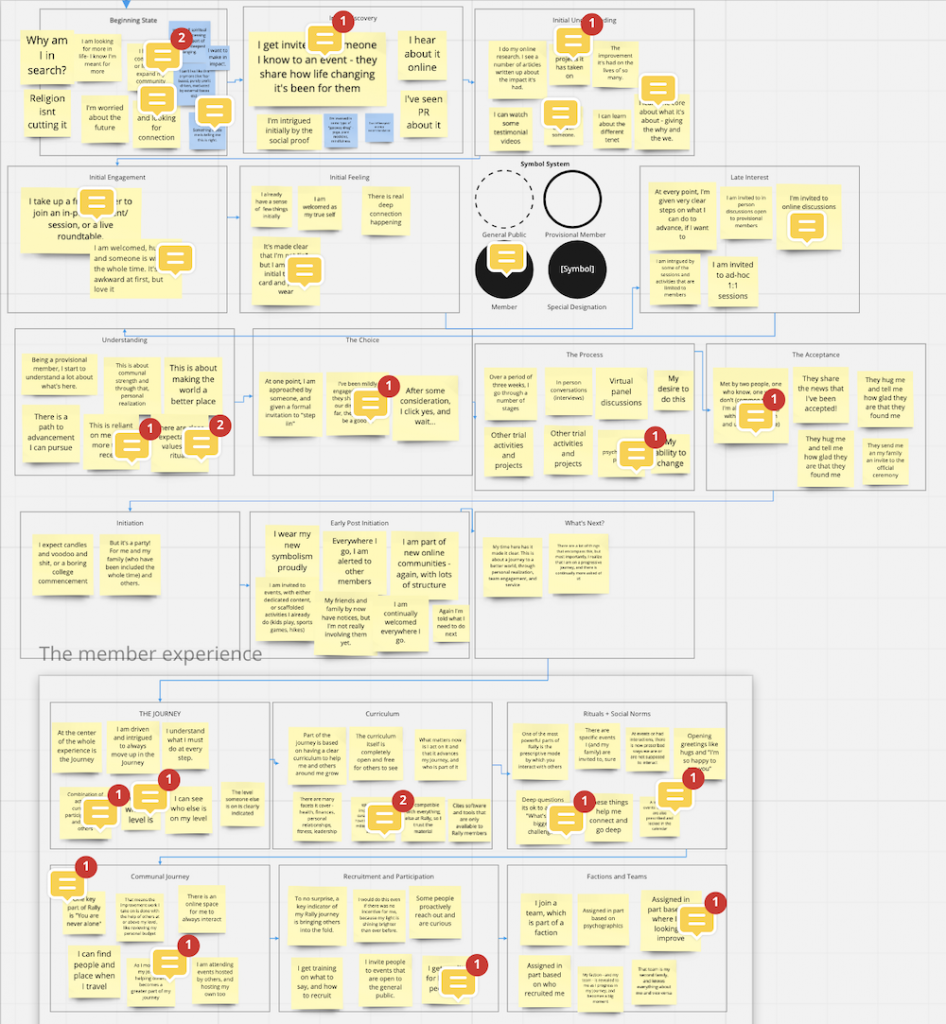
I knew that the only way to make real progress from that point on was to “start throwing clay on the wheel.” Living in concept land was starting to see diminishing returns, and I felt strongly that my learning would be accelerated by bringing something down to earth. I forced myself to pick the best direction that felt suitable for an MVP, and started putting a test together.
The original concept for Rally was a platform for self-paced courses that would weave in a strong community element. “Come for the content, stay for the community” was a thread that kept showing up in my exploration and research. A “want more friends, click here!” or “come over here if you’re feeling lonely” button would not yield much success. Instead, we believe that we would have to attract people towards a specific objective they had in mind – the most obvious one being learning and growth. While they would attend to achieve the particular objective, they would end up building deep relationships – not just because they were surrounded by people who shared a similar goal, but because the platform intentionally brought people together. Learning nowadays is increasingly single-player, a deviation from our interdependent nature.
The MVP that was launched – pieced together through no-code solutions, a barebones Rails application, and a video provider – was a platform that would take someone on a self-paced guided path, designed by an instructor. While most online courses one takes online are built around a series of pieces of static content (a video, something to read, and maybe a lame quiz), Rally allowed a course builder to daisy chain together static content, journaling exercises, and most importantly of all, 1:1 conversations. Rather than someone taking a “class,” we referred to them as journeys – with the hope that participants wouldn’t come out with some additional bit of knowledge, but as a changed person.
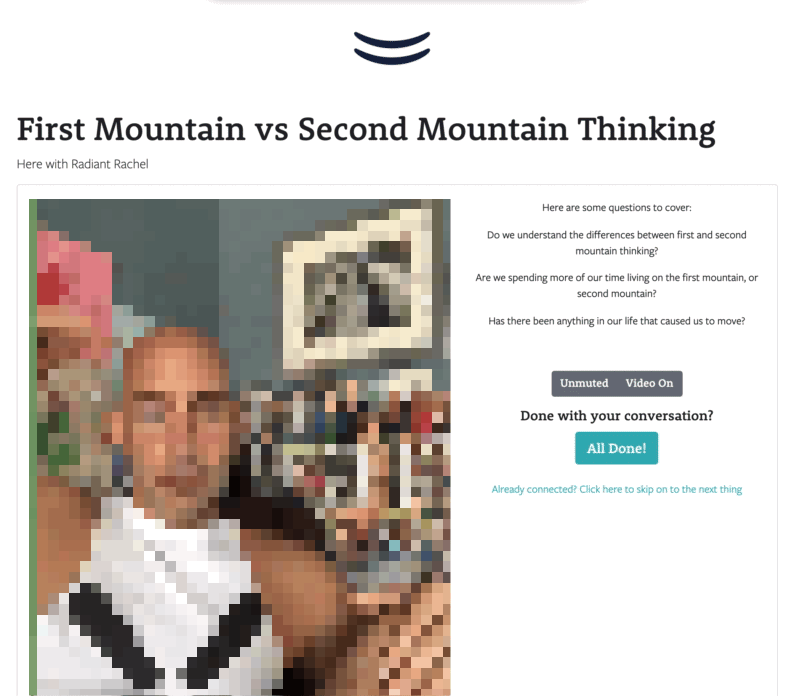
The video conversations to me was the most exciting part. By the time any two people arrived at a conversation checkpoint, they will have both read the same material, done similar journaling exercises, therefore they’d have something to talk about. Theoretically you could take any two strangers, and let them have a deep and meaningful conversation with each other. There was a fair bit of intentional thought put into the 1:1 conversations we had, which is why we didn’t just throw people on Zoom. Every conversation began with a breathing exercise, before you’d see the other participant. You’d each be able to see suggested topics and questions to ask each other, related to the stage in the program you were in. You could only see the other persons video, not your own

The vision entailed having many different journeys one could take around any desired objective, and eventually open it up to any course creator to build an experience that would help them both convey their desired topic and create a deep community in the process. I envisioned this as “islands in a pond” – rather than join a community and program dedicated to a single topic, you may join for a personal finance outcome, but, through building community and seeing what else is available, realize you also wanted to learn about mental fitness, and take a class there. As I shared this with other people, other use cases came up to apply the “self paced sequence of social activities” – e.g. could I join a journey dedicated to a specific book, and as I’m reading the book, the author has provided reflection prompts to help amplify the knowledge, and then I can discuss this 1:1 with people who just read the exact same chapter?
I ran some initial user acquisition tests and surveys to learn a little bit more about what topics a growth-minded person would be looking for, and “mindfulness” rose to the top as an area of interest. So I partnered with a good friend/coach to develop an initial body of content, meant to be done over a course of three weeks, and started bringing people in.
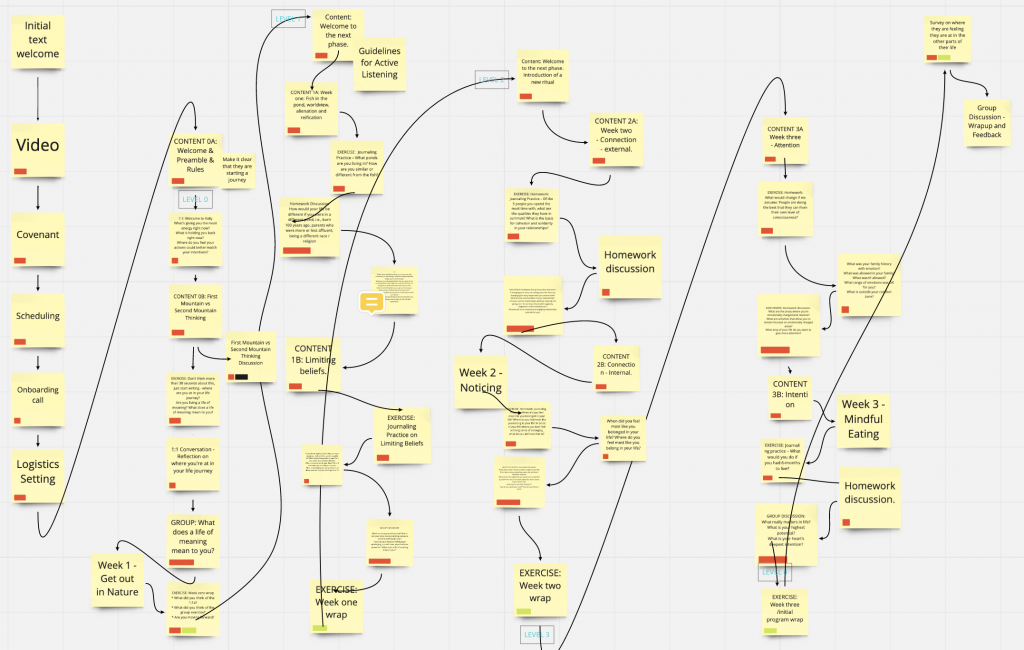
I’ll note here that I’m skipping over some of the more obvious parts. I didn’t just hide in a cave for six months, build and perfect a whole platform, obsess over the content, and then launch it when it was just right. The timeline is the jumbled macadam that one would expect – launch a form, get interest, scramble together the onboarding steps, build a barebones video conversation page, manually schedule people together, etc.
As I’m currently focused on Talk Social, which has some clear echoes of Rally in it, I won’t try and bury the lede any further. There were a lot of positive results, but a lot of major challenges that ended up being too hard to overcome, the good news is that it informed what we’d build next.
There were a lot of positive results
The people who got into it loved it. I truly believe we created something special, primarily through the ability to attract people from all different walks of life and bring them together for a deep conversation. Life goals. Motivations. Major blockers. None of the surface level small talk that we often get stuck into. For many, the content also resonated as well.
Some feedback from early users:
“We had an awesome conversation!! He was super nice and open with me, and we went through the prompts thoroughly and took time answering them. He was engaged and dedicated and I could tell that he wanted to be there. I really appreciate his willingness to share with me. We talked a lot about our childhood, spirituality, self-improvement, and mental health. Probably the best conversation I’ve ever had with a stranger.”
“The questions took us to some pretty interesting places. We talked about spirituality and morality, and I found myself deeply appreciating that we could just dive in and talk about that within a few minutes of meeting each other.”
“Such a great guy. Nearly 2 hours of conversation later, and it feels like we’ve known each other for several months. [name redacted] is a joy to chat with, and I was blown away at the vulnerability he shared.”
“I fucking love this (pardon my French). Rally has been such a cool experience for me and I have gotten so much out of it. I have started to journal more, meditate more, and start focusing my time thinking positive thoughts using the law of attraction. I have learned that I need to live my own life and be me, and stop getting so caught up in the lives of other people.”
“Really enjoying meeting others. This is a new way to connect with others that isn’t about work. Sure, “work” comes up, but I feel more connected to the folks I meet through Rally than anywhere else, especially during this coronavirus time.”
“I’ve really enjoyed the 1-on-1’s and talking to people who have similar interests.”
“Really smooth conversation. I felt like we easily could have gone on for another hour.”
There was also another undertone that I found interesting. We did not isolate our messaging to just the value for the single user. We spent just as much time speaking to our larger mission of bringing humanity back together. Increasing global consciousness. All the kool-aid I was chugging, I wanted others to know/hear about as well. We had many people come through who initially said they didn’t understand what Rally was, but it sounded like they could be part of something greater.
We also surfaced, through our user acquisition and onboarding, that there was some real pain in the world that people were willing to share:
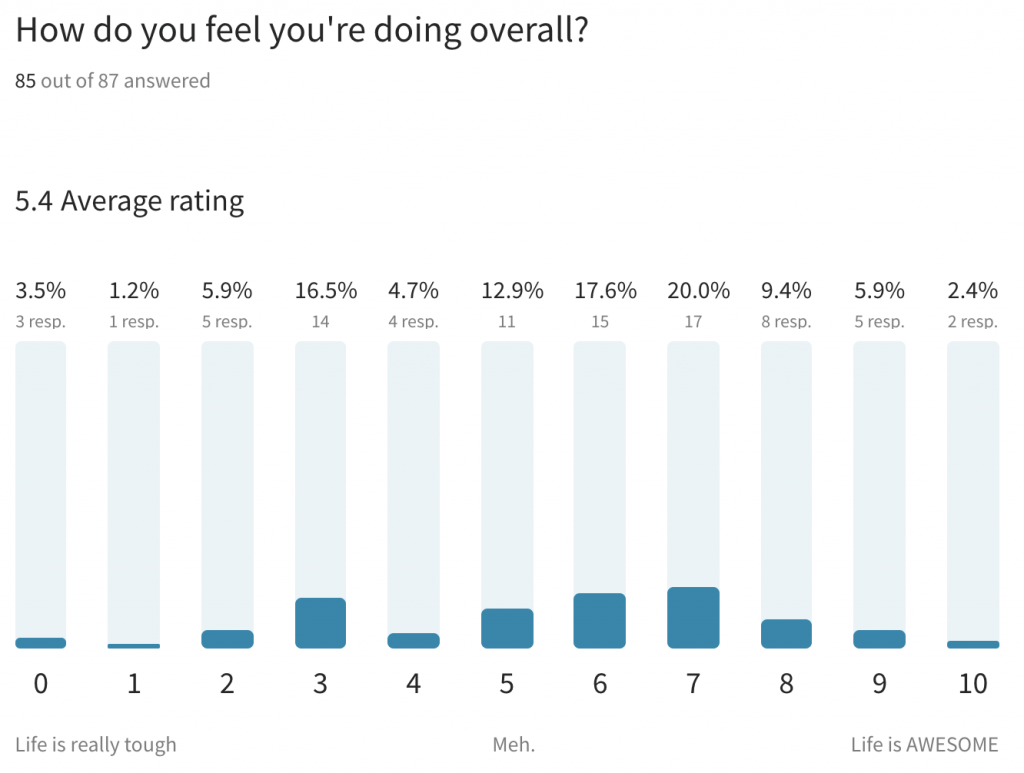
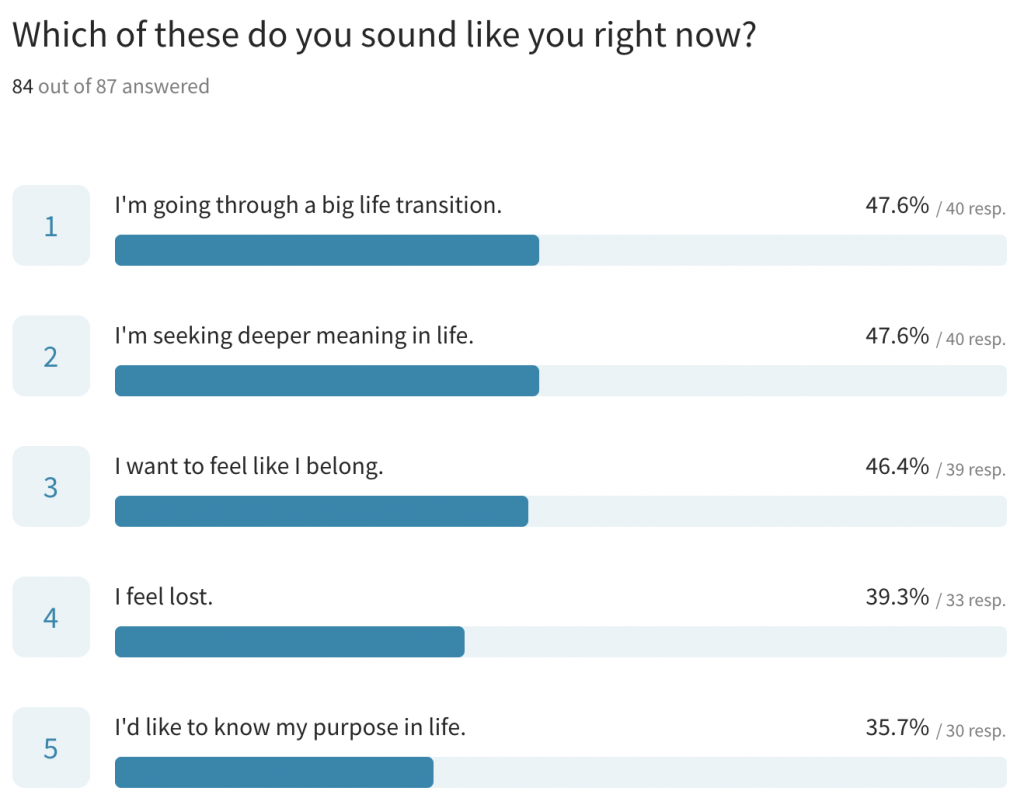
…but a lot of major challenges that ended up being too hard to overcome
In large part, people didn’t “get it.” I’ve always known my kryptonite is being able to properly explain a complex product I’m working on to someone without them seeing it, but this definitely was challenging. A community built around personal growth? A collaborative online class? Explaining the model behind Rally was a challenge – but it manifested itself in users not knowing what to do next, despite the big “Click here to move forward” buttons or “Your next step” email notifications. Rather than try and over-explain it, I started opting towards mystery – it was intentional that you didn’t understand much – you just always knew there was a next step for you (I was inspired by the Latitude Society and related experiments). But still, the uncertainty and mystery, without some social proof behind it, yielded a lot of hesitation amongst visitors. I learned about this thread months later, with enough distance to find it hilarious. Trust or clarity needs to exist.
Hesitation around talking to strangers. The biggest drop-off in our onboarding funnel was the step where someone would be getting on the phone with someone else in the program that they didn’t know. Most didn’t move forward at all and disappear, and the majority of the remainder would no-show their scheduled time. I wasn’t too surprised by this – the hypervigilance of loneliness and isolation (i.e. the more disconnected we feel, the less socially gregarious we tend to be), engagement over video, and the general distrust and bad behavior of total strangers online is a killer cocktail. Even if you had a positive conversation previously, that would give you a little more trust in the platform, but your expectations would be reset by the slot-machine premise of meeting another stranger in a follow-on call. What I was disappointed by was our inability to iterate out of it – we tried asynchronous journal sharing and discussion to warm people up, group video calls, text message engagement, 1:1 onboarding with me, but nothing moved the needle. Speaking 1:1 to strangers (as opposed to an existing relationship) is a big hill to climb.
Scheduling. This was not a shocker, but the logistics involved in getting you on a video call with someone else are challenging until the system has enough density. We iterated a lot here – moving from just introducing two people and letting them figure it out, to letting people pick time slots and matching off that, to limiting to 2-3 timeslots a week where we’d match anyone who showed up. We saw some progress here, but the fear over talking to strangers, and the low level of understanding of the overall system, and therefore purpose for showing up at all, had us starting with one hand tied behind our back.
…the good news is that it informed what we’d build next.
The cloud of learnings and momentum from building up “Rally v0” as we’d later refer to it as led to what we’re building now. What people loved most was the guided intentional conversation, breaking beyond the surface level small talk (and furthermore, group conversation was one of the most requested features). Bringing two complete strangers together with no common bond doesn’t work – what if they both had a common connection that brought them together? People loved the greater vision of bringing people together.
After a few months of Rally in market, we had enough excitement about our learnings that we started to pivot towards this new vision. While we adhered to the principle that an early stage venture is about rapid experimentation and ruthless culling of what doesn’t work, it was still tough to put to bed what could have been. That being said, the improved instantiation we’re iterating on now so far is yielding much more promise. The last nail in the coffin was realizing that Rally – of French origin ‘bring together again’ was too crowded a term, so even the brand was abandoned – in favor of Talk Social.
I still look at the concept canvas for Rally and believe there is tremendous potential. Personal growth & knowledge acquisition is a desire shared by most, and all too often, it’s a single player journey. With few exceptions, we read books by ourselves, stare at a computer screen watching a lecture, and do “homework” by ourselves. All the while, the best learning happens through others, and the vulnerability that growth affords opens up a channel to build the deep relationships for a life well lived.
But… Talk Social.
 Here for the first time?
Here for the first time?
7tclqn
086c64
pz8dac
3he263
id5nu3
vym261
3neijo
hazizu